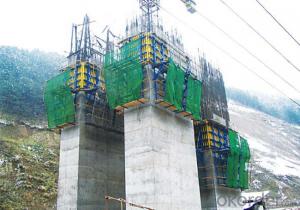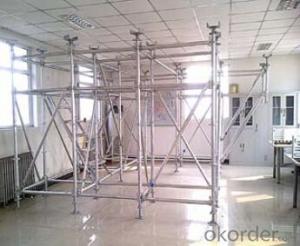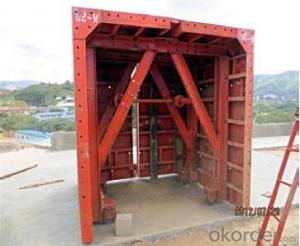Climbing Bracket CB240 for formwork and scaffolding systems
- Loading Port:
- Tianjin
- Payment Terms:
- TT OR LC
- Min Order Qty:
- 50 m²
- Supply Capability:
- 1000 m²/month
OKorder Service Pledge
OKorder Financial Service
You Might Also Like
Climbing Bracket CB240 & CB210
They are framework brackets for supporting large-area wall formwork.
Typical applications for the CB240&CB210 are pier and column/shear wall/core walll/ in the
building.
CB210 has smaller size than CB240, it will be cost effective in some condition.
Characteristics:
◆ High bearing capacity
The high loading capacity of the brackets allow very large scaffold units. This saves the number
anchor points required as well as reducing climbing times.
◆ Simple moving procedure by crane
Through the strong connection of formwork together with the climbing scaffold, both can be moved
as a single climbing unit by crane. Thus valuable time-savings can be achieved.
◆ Fast striking process without a crane
With the retrusive set, large formwork elements can also be retracted quickly and a minimum of
effort.
◆ Safe with work platform
The platforms have assembled firmly with bracket and will be climbing together, without scaffolding
but can work safely in spite of your high location.
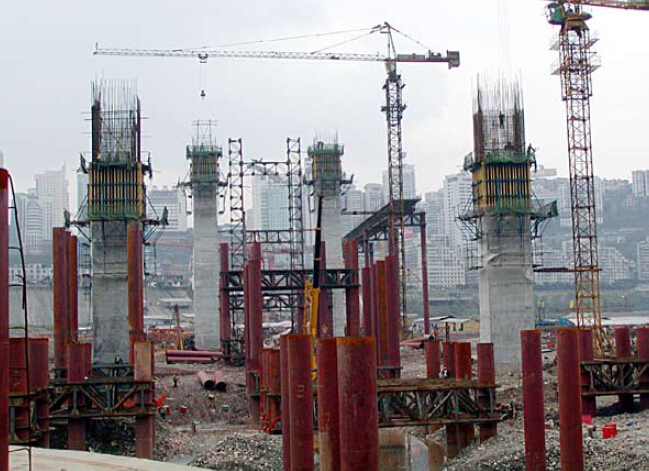
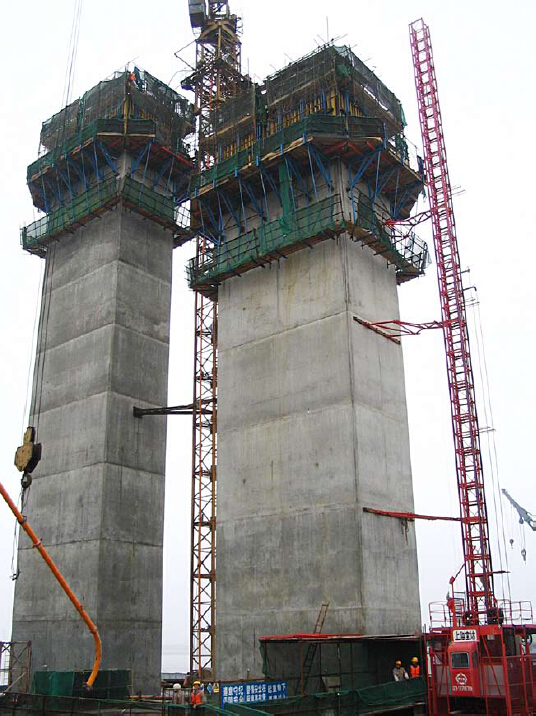
- Q: What are the advantages and disadvantages of the application of the steel formwork and the plywood formwork in the construction?
- According to the area of the project, such as the number of layers to determine the type of templateFrom the perspective of saving wood, the state generally encourage the use of steel formwork
- Q: What are the main components of a steel formwork system?
- The main components of a steel formwork system are the steel panels, walers, stiffeners, and connectors. 1. Steel Panels: These are the primary components of a steel formwork system. They are typically made of high-quality steel and come in various sizes and shapes. Steel panels provide the necessary strength and rigidity to hold the concrete in place during the construction process. They are designed to be easily assembled and disassembled, allowing for efficient use on different construction projects. 2. Walers: Walers are horizontal beams or rods that are used to connect and brace the steel panels. They help distribute the load of the concrete and provide additional strength to the formwork system. Walers are usually made of steel or timber and are placed along the edges of the formwork to maintain its shape and prevent any deformation. 3. Stiffeners: Stiffeners are vertical or diagonal members that are added to the steel formwork system to increase its stability and resistance to lateral forces. They are typically made of steel and are placed at regular intervals to provide additional support and prevent any buckling or twisting of the formwork system. Stiffeners are essential for ensuring the safety and integrity of the formwork during the pouring and curing of the concrete. 4. Connectors: Connectors are used to securely fasten the steel panels and other components of the formwork system. They can include various types of bolts, nuts, clamps, or pins. Connectors play a crucial role in maintaining the alignment and stability of the formwork, ensuring that it can withstand the pressure exerted by the wet concrete. They are designed to be easily adjustable and removable, allowing for quick assembly and disassembly of the formwork system. Overall, a steel formwork system is composed of steel panels, walers, stiffeners, and connectors. These components work together to provide the necessary strength, stability, and flexibility required for the construction of concrete structures. The use of steel in the formwork system ensures durability, reusability, and ease of assembly, making it a popular choice in the construction industry.
- Q: What are the common design considerations for steel formwork in marine environments?
- In order to design steel formwork for marine environments, it is important to take into account several common considerations. These considerations are crucial to guarantee the durability and longevity of the formwork in the challenging marine environment. Some of the commonly considered design factors for steel formwork in marine environments are as follows: 1. Selecting the Right Materials: It is essential to choose appropriate materials that can withstand the corrosive effects of saltwater. To prevent rusting and deterioration, stainless steel or other corrosion-resistant alloys should be utilized. 2. Coatings and Surface Treatments: The application of protective coatings or surface treatments can enhance the corrosion resistance of the steel formwork. These coatings may include zinc-rich primers, epoxy coatings, or galvanization, which provide an extra layer of protection. 3. Reinforcement and Strengthening: Marine environments subject the formwork to significant forces like waves, currents, and impact from floating debris. To ensure structural integrity, reinforcement and strengthening measures, such as additional bracing or thicker steel sections, may be necessary. 4. Proper Drainage and Ventilation: Adequate drainage and ventilation play a crucial role in preventing the accumulation of water, which can accelerate corrosion. Designing the formwork with suitable drainage channels or weep holes can help eliminate trapped moisture. 5. Attention to Connection Details: Special consideration should be given to connection details in marine environments. To prevent premature failure due to corrosion, corrosion-resistant fasteners like stainless steel bolts or galvanized screws should be used. 6. Regular Maintenance and Inspection: Regular maintenance and inspection are vital to identify any signs of corrosion or damage. Scheduled cleaning, removal of marine growth, and the application of protective coatings as needed will help prolong the life of the formwork. 7. Environmental Factors: The marine environment is often exposed to extreme conditions such as high winds, tidal forces, and UV radiation. The design should take these factors into account to ensure that the formwork can withstand these environmental loads. In conclusion, designing steel formwork for marine environments requires careful consideration of material selection, coatings, reinforcement, drainage, connection details, maintenance, and environmental factors. By incorporating these considerations into the design process, engineers can ensure that the formwork will withstand the harsh marine conditions and provide a reliable and durable solution.
- Q: Can steel formwork be used in areas with high wind uplift forces?
- Indeed, areas with high wind uplift forces can accommodate the use of steel formwork. Renowned for its robustness and longevity, steel formwork is an ideal choice for construction ventures in regions prone to high wind uplift forces. By incorporating supplementary reinforcement and bracing, the steel formwork system can be tailored to endure these forces, ensuring steadfastness and averting potential harm or malfunction. Engineering calculations and structural analysis can be undertaken to ascertain the specific criteria essential for the steel formwork to withstand the formidable high wind uplift forces. Moreover, the implementation of appropriate installation and anchoring techniques can further fortify the steel formwork system against these forces.
- Q: What materials are used in steel formwork construction?
- A sturdy and durable structure is typically created in steel formwork construction by using a combination of materials. The main material used is steel, which provides excellent strength and rigidity to support the weight and pressure of the concrete during casting. In addition to steel, other materials such as plywood or timber are used to construct the formwork panels. These panels are made of high-quality plywood or timber boards that are strong enough to bear the weight of the concrete without bending or warping. To enhance the formwork structure, steel bars or rods are strategically placed within the formwork for additional support. This prevents any deformation or collapse of the structure while pouring the concrete. Various connectors, fasteners, and accessories are also utilized in steel formwork construction. These include bolts, nuts, clamps, wedges, and pins, among others. These components securely join and hold the formwork panels and reinforcement bars together, ensuring a stable and rigid structure. Overall, steel formwork construction involves using steel, plywood or timber, reinforcement bars, and various connectors and accessories. These materials collaborate to create a robust and reliable formwork system capable of withstanding the pressures and forces exerted during the concrete casting process.
- Q: Can steel formwork be used for both straight and curved walls?
- Yes, steel formwork can be used for both straight and curved walls.
- Q: What are the different types of steel formwork systems available in the market?
- There are several different types of steel formwork systems available in the market, including traditional steel formwork, modular steel formwork, and panelized steel formwork. Traditional steel formwork consists of steel plates or frames that are assembled on-site to create the desired formwork shape. Modular steel formwork is pre-engineered and consists of standardized panels that can be easily assembled and reused. Panelized steel formwork is similar to modular steel formwork but consists of large panels that are interconnected to create the desired formwork shape.
- Q: Can steel formwork be used for industrial projects?
- Yes, steel formwork can be used for industrial projects. Steel formwork is highly durable and strong, making it suitable for heavy-duty industrial applications. It can withstand high pressure and load, making it ideal for constructing structures like industrial buildings, factories, warehouses, and power plants. Steel formwork is also resistant to weather conditions, chemicals, and corrosion, ensuring its long-lasting performance in industrial environments. Additionally, steel formwork offers flexibility and can be easily customized to meet specific project requirements. Overall, its strength, durability, and adaptability make steel formwork an excellent choice for industrial projects.
- Q: What are the common problems encountered with steel formwork?
- Construction projects can encounter several common problems with steel formwork. One primary issue involves corrosion. When exposed to moisture or harsh environments, steel formwork is susceptible to rust and deterioration. This can compromise the structure's integrity, weakening it and creating potential safety hazards. Another problem arises from the heavy weight of steel formwork, making its handling and transportation difficult. This challenge is particularly evident on-site, especially in tight spaces or high-rise buildings. Moreover, the weight of the steel formwork increases labor and equipment costs required for installation. Additionally, regular maintenance is necessary to prevent damage and ensure the longevity of steel formwork. This maintenance involves cleaning, repairing any corrosion or dents, and applying protective coatings to prevent further deterioration. However, this maintenance can be both time-consuming and costly, contributing to the overall project expenses. Furthermore, steel formwork may not be suitable for certain construction applications. It lacks the easy customization and adjustability found in other formwork materials like timber or plastic. Consequently, its flexibility in accommodating unique shapes or designs is limited. Lastly, steel formwork generally incurs higher costs compared to other formwork materials. This financial aspect can impact the project budget, particularly for smaller or budget-constrained construction projects. To ensure a successful construction project, it is crucial to acknowledge these common problems and take necessary precautions. This involves regular maintenance, proper handling, and considering alternative formwork materials when appropriate. By addressing these issues, the durability and strength offered by steel formwork can be maximized.
- Q: What is the weight of steel formwork?
- The weight of steel formwork can vary depending on its size and thickness. However, on average, steel formwork typically weighs around 20 to 25 kilograms per square meter.
Send your message to us
Climbing Bracket CB240 for formwork and scaffolding systems
- Loading Port:
- Tianjin
- Payment Terms:
- TT OR LC
- Min Order Qty:
- 50 m²
- Supply Capability:
- 1000 m²/month
OKorder Service Pledge
OKorder Financial Service
Similar products
Hot products
Hot Searches
